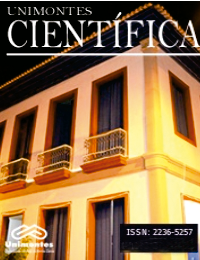AVALIAÇÃO E COMPARAÇÃO DA RESISTÊNCIA À COMPRESSÃO E À TRAÇÃO DIAMETRAL DE CIMENTOS ODONTOLÓGICOS
Keywords:
Cimentos Dentários; Resistência à Tração; Resistência à CompressãoAbstract
Objetivo: o objetivo deste estudo foi avaliar e comparar a resistência à compressão e à tração
diametral de oito cimentos utilizados em prótese fixa: fosfato de zinco (Cimento de Zinco – SS White e
Poscal – Voco), ionômero de vidro convencional (Meron – Voco e Ketac Cem – ESPE), ionômero de vidro
modificado por resina (Meron Plus – Voco) e cimentos resinosos (Rely-X – ESPE, Enforce – Dentsply
e Bifix – Voco). Materiais e métodos: para avaliação da resistência à compressão e à tração diametral
foram confeccionados dez corpos de prova para cada teste. As amostras foram carregadas com força de
compressão com uma velocidade de carregamento de 0,5mm/min em uma máquina de ensaio universal
(EMIC DL 2000) para ambos os testes. Os dados foram submetidos aos testes de ANOVA e Tukey (α=0,05).
Resultados: avaliando-se a resistência à compressão, os valores mais baixos foram obtidos pelos cimentos
Poscal e SS White que foram similares, estatisticamente, aos do Ketac Cem. Referente à tração diametral,
os menores valores, estatisticamente similares, foram obtidos pelos SS White, Poscal, Meron e Ketac Cem.
Os melhores resultados em relação à resistência à tração diametral e à compressão foram obtidos pelos
cimentos resisnosos. Conclusão: verificou-se que os cimentos resinosos apresentaram melhor resistência
à compressão e à tração diamentral com diferença, estatisticamente, significativa dos demais. Além disso,
os cimentos de fosfato de zinco e ionômero de vidro convencional apresentaram os menores valores de
resistência para ambos os testes.
Downloads
References
Mechanical and physical properties of
contemporary dental luting agents. The Journal
of Prosthetic Dentistry. Amsterdam, v. 89, n. 2,
p. 127-134, 2003.
2. SIVAKUMAR, J. S.; SURESH KUMAR,
B. N.; SHYMALA P. V. Role of provisional
restorations in endodontic therapy. Journal of
pharmacy & bioallied sciences. Mumbai, v. 5,
suppl S1, p. 120-4, 2013.
3. DONOVAN, T. E.; CHO, G. C. Contemporary
evaluation of dental cements. Compendium of
continuing education in dentistry. Jamessburg,
v. 20, n. 3, p. 197-219, 1999.
4. PEGORARO, T. A.; DA SILVA, N. R. F. A.;
CARVALHO, R. M. Cements for Use in Esthetic
Dentistry. Dental clinics of North America.
Philadelphia, v. 51, n.2, p. 453-71, 2007.
5. KLEVERLAND, C.J.; VAN DUINEN, R.
N. B.; FEILZER, A.J. Mechanical properties
of glass ionomer cements affected by curing
methods. Dental Materials. Oxford, v. 20, n. 1,
p. 45-50, 2004.
6. HOLDEREGGER, C. et al. Shear bond strength
of resin cements to human dentin. Dental
Materials. Oxford, v. 24, n. 7, p. 944-50, 2008.
7. LAD, P. P. et al. Practical clinical considerations
of luting cement: a review. Journal of
International Oral Health. Ahmedabad, v.6,
n.1, p.116-120. 2014.
8. ORSI, I. A. et al. In vitro tensile strength of
luting cements on metallic substrate. Brazilian
Dental Journal. Ribeirão Preto, v. 25, n. 2, p.
136-40, 2014.
9. PATIL SG, SURESH SAJJAN MC, PATIL
R. The effect of temperature on compressive
and tensile strengths of commonly used
luting cements: an in vitro study. Journal of
International Oral Health. Ahmedabad, v. 7, n.
2, p. 13-19, 2015.
10. TANOMARU-FILHO, M. et al.
Compressive Strength and Setting Time
of MTA and Portland Cement Associated
with Different Radiopacifying Agents.
International scholarly research notices. Cairo,
v. 2012. 2012.
11. LI, Z. C.; WHITE, S. N. Mechanical proprieties
of dental luting cements. Journal of Prosthetic
Dentistry. Amsterdam, v. 81, n. 5, p. 597-609,
1999.
12. WHITE, S. N.; Yu Z. Physical properties of
fixed prosthodontic, resin composite luting
agents. International Journal of Prosthodontic,
v. 69, n. 6, p. 384-9, 1993.
13. PIWOWARCZYK A. et al Laboratory strength
of glass ionomer cement, cement, compomers
and resin composites. Journal of Prosthodontic.
Philadelphia, v. 11, n. 2, p.86-91, 2002.
14. GOÉS MF. Cimentos resinosos. São Paulo:
Artes Médicas; 1998.
15. ANUSAVICE KJ. Phillips materiais dentários.
11ª ed. Rio de Janeiro: Elsevier; 2003.
16. PARAMESWARIL B. D. et al. Comparative
study on the tensile bond strength and marginal
fit of complete veneer cast metal crowns using
various luting agents: An in vitro study. Journal
of pharmacy and bioallied Science. Mumbai, v.
8, n.5, p. 138-42, 2016.
17. XIE, D. et al. Mechanical properties and
microstructures of glass-ionomer cement.
Dental Materials. Oxford, v.16, n. 2, p. 129-
38, 2000.












